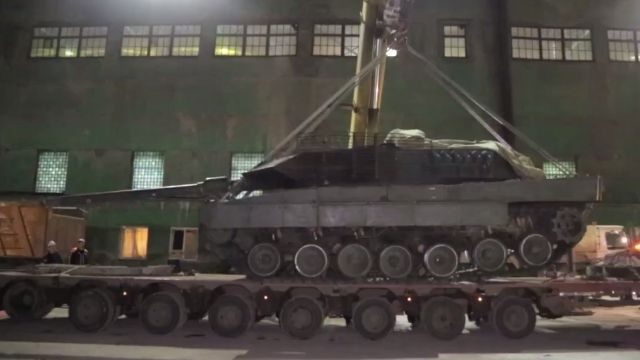 Russian sources released footage showing a cargo truck transporting the captured Leopard 2A6 to the factory, where it was offloaded by a heavy-duty crane.
Russian sources released footage showing a cargo truck transporting the captured Leopard 2A6 to the factory, where it was offloaded by a heavy-duty crane.
Photo: Bulgarian Military
Uralvagonzavod, Russia’s largest tank manufacturer, has announced that the captured Leopard 2A6 tank has been completely disassembled and analyzed. BulgarianMilitary.com recalls that on October 1st, Russian sources released footage showing a cargo truck transporting the captured Leopard 2A6 to the factory, where it was offloaded by a heavy-duty crane.
Experts at Uralvagonzavod specifically examined the German Leopard 2A6, which, according to foreign media, was taken from the Bundeswehr’s reserves, as these tanks are not meant for export. This could suggest the presence of sensitive technologies, but according to Sputnik, citing a representative from Uralvagonzavod, nothing of the sort was found.
“Our engineers have dismantled and analyzed the Western equipment captured during the special military operation, and it revealed nothing extraordinary in terms of design,” said the Uralvagonzavod representative. “No breakthrough innovations were discovered,” another company official told Sputnik.
Despite these claims, experts remain skeptical. Their doubts focus primarily on the potential for the release of sensitive information. They suggest that even if breakthrough technologies were discovered, the engineers were likely instructed by the Russian Ministry of Defense to withhold this information from the media. This, they argue, would give the Russian military an edge on the battlefield.
These suspicions are further supported by the fact that the tank brought to Uralvagonzavod was an A26 variant, one of the most advanced operational versions of the Leopard 2A6. According to Western sources, the tank was taken directly from the German army’s reserves and delivered as a donation to Ukraine.
The Leopard 2A6, widely regarded as one of the most advanced main battle tanks, is built on cutting-edge German engineering and integrates some of the most sophisticated systems available. By dismantling and analyzing the tank, Russian engineers could aim to uncover information that might give them an edge in modern armored warfare.
One of the primary focuses would likely be the tank’s armor composition. The Leopard 2A6 is known for its advanced composite armor, which includes ceramic, steel, and other classified materials. Understanding the structure and materials of this armor could help Russian scientists improve their own designs or develop weapons specifically tailored to penetrate it.
Another key area of interest would be the 120mm Rheinmetall L55 smoothbore gun, considered one of the most accurate and powerful tank guns in the world. Studying its rifling technology, barrel design, and recoil management systems might provide insights into why it outperforms many of its counterparts. Such knowledge could inform improvements to Russian artillery and tank armaments.
A captured Leopard 2A6 has arrived at Uralvagonzavod. This is the technically best preserved example. For the first time in history, UVZ specialists will be able to analyze the vehicle's combined…
The Leopard’s fire control system is another treasure trove of information. The tank features advanced target acquisition, thermal imaging, and ballistic computation systems that allow it to engage enemies with precision in a wide range of conditions.
Reverse engineering these systems could help Russia develop similar technology or identify vulnerabilities that could be exploited in combat.
The mobility systems of the Leopard 2A6, including its transmission and suspension, might also be of interest. This tank is known for its remarkable maneuverability despite its heavy weight. Understanding how its designers achieved this balance could influence the development of Russian armored vehicles.
However, perhaps the most sensitive information lies in the tank’s communication and network systems. Modern Western tanks are often designed to operate as part of a broader digital battlefield, sharing information in real-time. Access to the Leopard’s software and encryption systems could offer Russia a glimpse into how NATO coordinates its forces, potentially exposing weaknesses in battlefield communications.
While such an undertaking could provide valuable intelligence, reverse engineering is no simple feat. Modern military equipment often incorporates measures to prevent tampering, such as self-destruct mechanisms for sensitive electronics. Additionally, the value of any findings depends on the condition of the captured tank and whether critical components remain intact.
Despite these challenges, even minor revelations from the Leopard 2A6 could be leveraged to refine Russian military strategies and technologies. Whether these efforts yield significant breakthroughs or merely reinforce existing designs, the dismantling of a captured Leopard underscores the strategic importance of technological superiority in modern warfare.
The Russians also brought a US-made M1A1SA Abrams main battle tank captured from Ukraine to the Uralvagonzavod tank plant in Nizhny Tagil.
The same disassembly and reverse engineering process that took place with the Leopard 2A6 is now set to be carried out on a U.S.-delivered M1A1 Abrams tank.
On December 26th, a truck carrying a well-preserved American tank was spotted approaching the gates of Uralvagonzavod, Russia’s largest tank manufacturing plant. This marks another crucial step in Russia’s ongoing efforts to analyze captured Western military technology.
read more in our Telegram-channel https://t.me/The_International_Affairs

 11:30 08.01.2025 •
11:30 08.01.2025 •






















